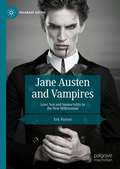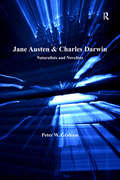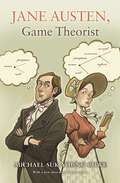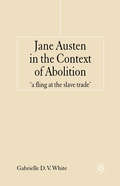- Table View
- List View
Jane Austen and Representations of Regency England
by Roger SalesIn Jane Austen and Representations of Regency England, Roger Sales looks at Jane Austen's entire oeuve, and views her historically as a Regency writer voicing concerns on the condition of England. Examining Austen's literary works; her letters - in the context of those of other Regency women; as well as contemporary texts such as television adaptations of her work, Jane Austen and Representations of Regency England reconstructs the breadth of Jane Austen's writing. It also examines: * her representations of dandyism and masculine identities * the events of the Regency crisis of 1810-12 * the way in which Austen engaged in topical debates such as healthcare in both Emma and Persuasion.
Jane Austen and Sciences of the Mind (Routledge Studies in Romanticism)
by Edited by Beth LauThe essays in this volume interpret Jane Austen’s fiction through the lens of various sciences of the mind and brain, especially the cluster of disciplines implicated in the term cognitive science, including neuroscience, evolutionary biology, evolutionary and developmental psychology, and others. The field of cognitive literary studies has rapidly developed in the last few decades and achieved the status of an established (if still evolving) critical approach. One of the most popular authors to analyze from this perspective is Jane Austen. As numerous critics have noted, Austen was a keen observer of how the mind operates in its interactions with other minds, both when it functions successfully and when, as often happens, it goes awry, and her perceptions are often in synch with current neuroscientific and psychological research. Despite the widespread recognition of the special congruity between Austen’s novels and cognitive science, however, no book has been devoted to this subject. Jane Austen and Sciences of the Mind is the first monograph wholly comprised of readings of Austen’s oeuvre (juvenilia as well as all six completed novels) from cognitive and related psychological approaches. In addition, the volume operates under the assumption that cognitive and historicist approaches are compatible, and many essays situate Austen within the climate of ideas during her era as well as in relation to current research in the sciences and social sciences. Jane Austen and Sciences of the Mind offers a new lens for understanding and illuminating the concerns, techniques, and enduring appeal of Austen’s novels.
Jane Austen and Sciences of the Mind (Routledge Studies in Romanticism)
by Beth LauThe essays in this volume interpret Jane Austen’s fiction through the lens of various sciences of the mind and brain, especially the cluster of disciplines implicated in the term cognitive science, including neuroscience, evolutionary biology, evolutionary and developmental psychology, and others. The field of cognitive literary studies has rapidly developed in the last few decades and achieved the status of an established (if still evolving) critical approach. One of the most popular authors to analyze from this perspective is Jane Austen. As numerous critics have noted, Austen was a keen observer of how the mind operates in its interactions with other minds, both when it functions successfully and when, as often happens, it goes awry, and her perceptions are often in synch with current neuroscientific and psychological research. Despite the widespread recognition of the special congruity between Austen’s novels and cognitive science, however, no book has been devoted to this subject. Jane Austen and Sciences of the Mind is the first monograph wholly comprised of readings of Austen’s oeuvre (juvenilia as well as all six completed novels) from cognitive and related psychological approaches. In addition, the volume operates under the assumption that cognitive and historicist approaches are compatible, and many essays situate Austen within the climate of ideas during her era as well as in relation to current research in the sciences and social sciences. Jane Austen and Sciences of the Mind offers a new lens for understanding and illuminating the concerns, techniques, and enduring appeal of Austen’s novels.
Jane Austen and the Ethics of Description (Routledge Studies in Nineteenth Century Literature)
by Brett BourbonJane Austen and the Ethics of Description demonstrates that Elizabeth Bennet and her creator are misunderstood, and often unrecognized, geniuses of moral philosophy, but not simply because of their virtue or wit or natural skills in game theory. The engine driving the moral judgement and growth of Austen’s protagonists consists of a particular and not well-understood ability to reason by description, a skill which we moderns must recover and remaster in order to negotiate the complexities of contemporary life. The forms of rational description this volume derives from Austen will be of great interest to not only literary critics and theorists, but also to philosophers and anyone interested in ethics, the dynamics of power, and practical reasoning. Written in a clear style, the book is for those who love Austen and for those who want to understand how we should reason about our lives. The book is written for those who love Austen, of course, but also for those who are interested in questions about how to live and in fundamental and practical questions about power, social conflict, self-awareness, and practical reasoning. It is a literary analysis, a philosophical argument, and a practical guide to ethical thinking.
Jane Austen and the Ethics of Description (Routledge Studies in Nineteenth Century Literature)
by Brett BourbonJane Austen and the Ethics of Description demonstrates that Elizabeth Bennet and her creator are misunderstood, and often unrecognized, geniuses of moral philosophy, but not simply because of their virtue or wit or natural skills in game theory. The engine driving the moral judgement and growth of Austen’s protagonists consists of a particular and not well-understood ability to reason by description, a skill which we moderns must recover and remaster in order to negotiate the complexities of contemporary life. The forms of rational description this volume derives from Austen will be of great interest to not only literary critics and theorists, but also to philosophers and anyone interested in ethics, the dynamics of power, and practical reasoning. Written in a clear style, the book is for those who love Austen and for those who want to understand how we should reason about our lives. The book is written for those who love Austen, of course, but also for those who are interested in questions about how to live and in fundamental and practical questions about power, social conflict, self-awareness, and practical reasoning. It is a literary analysis, a philosophical argument, and a practical guide to ethical thinking.
Jane Austen and the French Revolution
by Warren RobertsThis book argues that Jane Austin did know of the French Revolution and its effects on the European world, even though she never refers to it directly in her writing.
Jane Austen and the Interplay of Character
by Ivor MorrisThe unique force of Jane Austen's novels lies in the interplay of character. Nothing much happens, on the surface; but, as in life, minor shifts and changes evoke enormous consequences in the lives of individuals. In this stimulating book, Ivor Morris anatomises one of her best-loved characters: 'conceited, pompous, narrow-minded, silly' Mr Collins.
Jane Austen and the Popular Novel: The Determined Author
by A. MandalThis book offers a reinterpretation of Austen's later novels by exploring their interactions with the fiction of the 1810s. Building on recent bibliographic research into the novel, this study situates Austen in the literary marketplace and offers new insights into the nature of her 'innovation', which arises from her sensitivity to the genre.
Jane Austen and the Reformation: Remembering the Sacred Landscape
by Roger Emerson MooreJane Austen's England was littered with remnants of medieval religion. From her schooling in the gatehouse of Reading Abbey to her visits to cousins at Stoneleigh Abbey, Austen faced constant reminders of the wrenching religious upheaval that reordered the English landscape just 250 years before her birth. Drawing attention to the medieval churches and abbeys that appear frequently in her novels, Moore argues that Austen's interest in and representation of these spaces align her with a long tradition of nostalgia for the monasteries that had anchored English life for centuries until the Reformation. Converted monasteries serve as homes for the Tilneys in Northanger Abbey and Mr. Knightley in Emma, and the ruins of the 'Abbeyland' have a prominent place in Sense and Sensibility. However, these and other formerly sacred spaces are not merely picturesque backgrounds, but tangible reminders of the past whose alteration is a source of regret and disappointment. Moore uncovers a pattern of critique and commentary throughout Austen's works, but he focuses in particular on Northanger Abbey, Mansfield Park, and Sanditon. His juxtaposition of Austen's novels with sixteenth- and seventeenth-century texts rarely acknowledged as relevant to her fiction enlarges our understanding of Austen as a commentator on historical and religious events and places her firmly in the long national conversation about the meaning and consequences of the Reformation.
Jane Austen and the Reformation: Remembering the Sacred Landscape
by Roger Emerson MooreJane Austen's England was littered with remnants of medieval religion. From her schooling in the gatehouse of Reading Abbey to her visits to cousins at Stoneleigh Abbey, Austen faced constant reminders of the wrenching religious upheaval that reordered the English landscape just 250 years before her birth. Drawing attention to the medieval churches and abbeys that appear frequently in her novels, Moore argues that Austen's interest in and representation of these spaces align her with a long tradition of nostalgia for the monasteries that had anchored English life for centuries until the Reformation. Converted monasteries serve as homes for the Tilneys in Northanger Abbey and Mr. Knightley in Emma, and the ruins of the 'Abbeyland' have a prominent place in Sense and Sensibility. However, these and other formerly sacred spaces are not merely picturesque backgrounds, but tangible reminders of the past whose alteration is a source of regret and disappointment. Moore uncovers a pattern of critique and commentary throughout Austen's works, but he focuses in particular on Northanger Abbey, Mansfield Park, and Sanditon. His juxtaposition of Austen's novels with sixteenth- and seventeenth-century texts rarely acknowledged as relevant to her fiction enlarges our understanding of Austen as a commentator on historical and religious events and places her firmly in the long national conversation about the meaning and consequences of the Reformation.
Jane Austen and the State of the Nation
by Eckersley Sheryl CraigJane Austen and the State of the Nation explores Jane Austen's references to politics and to political economics and concludes that Austen was a liberal Tory who remained consistent in her political agenda throughout her career as a novelist. Read with this historical background, Austen's books emerge as state-of-the-nation or political novels.
Jane Austen and the Victorian Heroine
by Cheryl A. WilsonThis book uses the figure of the Victorian heroine as a lens through which to examine Jane Austen’s presence in Victorian critical and popular writings. Aimed at Victorianist readers and scholars, the book focuses on the ways in which Austen was constructed in fiction, criticism, and biography over the course of the nineteenth century. For the Victorians, Austen became a kind of cultural shorthand, representing a distant, yet not too-distant, historical past that the Victorians both drew on and defined themselves against with regard to such topics as gender, literature, and national identity. Austen influenced the development of the Victorian literary heroine, and when cast as a heroine herself, was deployed in debates about the responsibilities of the novelist and the ability of fiction to shape social and cultural norms. Thus, the study is as much, if not more, about the Victorians than it is about Jane Austen.
Jane Austen and Vampires: Love, Sex and Immortality in the New Millennium (Palgrave Gothic)
by Eric ParisotJane Austen and Vampires is the first book to investigate the literary convergence of Jane Austen and vampires in Austen fanfic after the success of Stephenie Meyer’s Twilight (2005) and Seth Grahame-Smith’s Pride and Prejudice and Zombies (2009). It asks how the shifting cultural values of Austen and the vampire have aligned, and what their connection might mean for their respective contemporary legacies. It also makes a case for reading “low brow” Austen fanfic attentively, as a way to gain meaningful insight directly from Austen fans into the tensions and anxieties surrounding contemporary notions of love, sex, femininity, and Austen’s modern currency. Offering close readings of Austen’s vampire-slaying heroines, vampiric retellings of Pride and Prejudice, and the transformation of Austen herself into a vampire, this book reveals Austen-vampire mashups as messy, complex entanglements that creatively and self-reflexively interrogate modern fantasies of vampire romance. By its unique intersection of Jane Austen with the vampire, the Gothic, fan culture and popular romance, Jane Austen and Vampires adds a new chapter to the history of Austen’s reception, for fans, students and scholars alike.
Jane Austen and William Shakespeare: A Love Affair in Literature, Film and Performance
by Marina Cano Rosa García-PeriagoThis volume explores the multiple connections between the two most canonical authors in English, Jane Austen and William Shakespeare. The collection reflects on the historical, literary, critical and filmic links between the authors and their fates. Considering the implications of the popular cult of Austen and Shakespeare, the essays are interdisciplinary and comparative: ranging from Austen’s and Shakespeare’s biographies to their presence in the modern vampire saga Twilight, passing by Shakespearean echoes in Austen’s novels and the authors’ afterlives on the improv stage, in wartime cinema, modern biopics and crime fiction. The volume concludes with an account of the Exhibition “Will & Jane” at the Folger Shakespeare Library, which literally brought the two authors together in the autumn of 2016. Collectively, the essays mark and celebrate what we have called the long-standing “love affair” between William Shakespeare and Jane Austen—over 200 years and counting.
Jane Austen at Home: A Biography
by Lucy WorsleyTHE SUNDAY TIMES BESTSELLER'This is my kind of history: carefully researched but so vivid that you are convinced Lucy Worsley was actually there at the party - or the parsonage.' Antonia Fraser'A refreshingly unique perspective on Austen and her work and a beautifully nuanced exploration of gender, creativity, and domesticity.' Amanda ForemanLucy Worsley 'is a great scene-setter for this tale of triumph and heartbreak.' Sunday TimesOn the 200th anniversary of Jane Austen's death, historian Lucy Worsley leads us into the rooms from which our best-loved novelist quietly changed the world.This new telling of the story of Jane's life shows us how and why she lived as she did, examining the places and spaces that mattered to her. It wasn't all country houses and ballrooms, but a life that was often a painful struggle. Jane famously lived a 'life without incident', but with new research and insights Lucy Worsley reveals a passionate woman who fought for her freedom. A woman who far from being a lonely spinster in fact had at least five marriage prospects, but who in the end refused to settle for anything less than Mr Darcy.
Jane Austen & Charles Darwin: Naturalists and Novelists
by Peter W. GrahamAre Jane Austen and Charles Darwin the two great English empiricists of the nineteenth century? Peter W. Graham poses this question as he brings these two icons of nineteenth-century British culture into intellectual conversation in his provocative new book. Graham shows that while the one is generally termed a naturalist (Darwin's preferred term for himself) and the other a novelist, these characterizations are at least partially interchangeable, as each author possessed skills that would serve well in either arena. Both Austen and Darwin are naturalists who look with a sharp, cold eye at the concrete particulars of the world around them. Both are in certain senses novelists who weave densely particularized and convincingly grounded narratives that convey their personal observations and perceptions to wide readerships. When taken seriously, the words and works of Austen and Darwin encourage their readers to look closely at the social and natural worlds around them and form opinions based on individual judgment rather than on transmitted opinion. Graham's four interlocked essays begin by situating Austen and Darwin in the English empirical tradition and focusing on the uncanny similarities in the two writers' respective circumstances and preoccupations. Both Austen and Darwin were fascinated by sibling relations. Both were acute observers and analysts of courtship rituals. Both understood constant change as the way of the world, whether the microcosm under consideration is geological, biological, social, or literary. Both grasped the importance of scale in making observations. Both discerned the connection between minute, particular causes and vast, general effects. Employing the trenchant analytical talents associated with his subjects and informed by a wealth of historical and biographical detail and the best of recent work by historians of science, Graham has given us a new entree into Austen's and Darwin's writings.
Jane Austen & Charles Darwin: Naturalists and Novelists
by Peter W. GrahamAre Jane Austen and Charles Darwin the two great English empiricists of the nineteenth century? Peter W. Graham poses this question as he brings these two icons of nineteenth-century British culture into intellectual conversation in his provocative new book. Graham shows that while the one is generally termed a naturalist (Darwin's preferred term for himself) and the other a novelist, these characterizations are at least partially interchangeable, as each author possessed skills that would serve well in either arena. Both Austen and Darwin are naturalists who look with a sharp, cold eye at the concrete particulars of the world around them. Both are in certain senses novelists who weave densely particularized and convincingly grounded narratives that convey their personal observations and perceptions to wide readerships. When taken seriously, the words and works of Austen and Darwin encourage their readers to look closely at the social and natural worlds around them and form opinions based on individual judgment rather than on transmitted opinion. Graham's four interlocked essays begin by situating Austen and Darwin in the English empirical tradition and focusing on the uncanny similarities in the two writers' respective circumstances and preoccupations. Both Austen and Darwin were fascinated by sibling relations. Both were acute observers and analysts of courtship rituals. Both understood constant change as the way of the world, whether the microcosm under consideration is geological, biological, social, or literary. Both grasped the importance of scale in making observations. Both discerned the connection between minute, particular causes and vast, general effects. Employing the trenchant analytical talents associated with his subjects and informed by a wealth of historical and biographical detail and the best of recent work by historians of science, Graham has given us a new entree into Austen's and Darwin's writings.
Jane Austen, Early and Late
by Freya JohnstonA reexamination of Austen’s unpublished writings that uncovers their continuity with her celebrated novels—and that challenges distinctions between her “early” and “late” workJane Austen’s six novels, published toward the end of her short life, represent a body of work that is as brilliant as it is compact. Her earlier writings have routinely been dismissed as mere juvenilia, or stepping stones to mature proficiency and greatness. Austen’s first biographer described them as “childish effusions.” Was he right to do so? Can the novels be definitively separated from the unpublished works? In Jane Austen, Early and Late, Freya Johnston argues that they cannot.Examining the three manuscript volumes in which Austen collected her earliest writings, Johnston finds that Austen’s regard and affection for them are revealed by her continuing to revisit and revise them throughout her adult life. The teenage works share the milieu and the humour of the novels, while revealing more clearly the sources and influences upon which Austen drew. Johnston upends the conventional narrative, according to which Austen discarded the satire and fantasy of her first writings in favour of the irony and realism of the novels. By demonstrating a stylistic and thematic continuity across the full range of Austen’s work, Johnston asks whether it makes sense to speak of an early and a late Austen at all.Jane Austen, Early and Late offers a new picture of the author in all her complexity and ambiguity, and shows us that it is not necessarily true that early work yields to later, better things.
A Jane Austen Encyclopedia
by Paul PoplawskiPerhaps the first modern novelist, Jane Austen (1775-1817) has left an indelible mark on the world of letters. She is best known as the author of penetrating studies of domestic life and manners, and her novels such as Sense and Sensibility (1811), Pride and Prejudice (1813), and Mansfield Park (1814) continue to be read and appreciated today. Yet Austen also wrote numerous other pieces and a substantial body of letters. While her novels have received large amounts of critical attention, scholars have also increasingly studied her other writings, and Austen scholarship continues to grow each year. This reference book is an accurate, comprehensive, and detailed guide to her life and career.A chronology outlines the principal events in her life and places her within larger literary and historical contexts. The several hundred alphabetically arranged entries that follow identify characters and family members, discuss works and themes, and synthesize the large body of criticism that has grown around her works. Every one of her texts, including all of her minor writings, has a separate entry, as have most of her fictional characters. Entries for individual works typically provide details of composition and publication, a plot summary and critical commentary, a list of characters, and bibliographical references. The volume closes with an extensive bibliography of works by and about her.
Jane Austen, Feminism and Fiction: Second Edition
by Margaret KirkhamA classic account of Jane Austen in the context of eighteenth century feminist ideas and contemporary thought.
Jane Austen, Game Theorist
by Michael Suk-Young ChweGame theory—the study of how people make choices while interacting with others—is one of the most popular technical approaches in social science today. But as Michael Chwe reveals in his insightful new book, Jane Austen explored game theory's core ideas in her six novels roughly two hundred years ago—over a century before its mathematical development during the Cold War. Jane Austen, Game Theorist shows how this beloved writer theorized choice and preferences, prized strategic thinking, and analyzed why superiors are often strategically clueless about inferiors. Exploring a diverse range of literature and folktales, this book illustrates the wide relevance of game theory and how, fundamentally, we are all strategic thinkers.
Jane Austen, Game Theorist
by Michael Suk-Young ChweGame theory—the study of how people make choices while interacting with others—is one of the most popular technical approaches in social science today. But as Michael Chwe reveals in his insightful new book, Jane Austen explored game theory's core ideas in her six novels roughly two hundred years ago—over a century before its mathematical development during the Cold War. Jane Austen, Game Theorist shows how this beloved writer theorized choice and preferences, prized strategic thinking, and analyzed why superiors are often strategically clueless about inferiors. Exploring a diverse range of literature and folktales, this book illustrates the wide relevance of game theory and how, fundamentally, we are all strategic thinkers.
Jane Austen in the Context of Abolition: 'a fling at the slave trade'
by G. WhiteThis wide-ranging and convincingly argued study looks at the issues of and attitudes towards slavery in Jane Austen's later novels and culture, and argues against Edward Said's critique of Jane Austen as a supporter of colonialism and slavery. White suggests that Austen is both concerned and engaged with the issue, and that novels such as Mansfield Park, Emma and Persuasion not only presuppose the British outlawing of the transatlantic slave trade but also undermine the status quo of chattel slavery, slavery's most extreme form.



















